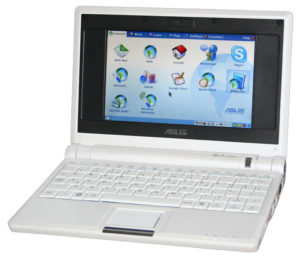Posted on August 24, 2018
Asus Eee PC 700 Series
The Asus Eee PC released back in 2007 bears some historic significance, as it was the first time ever affordable ultra mobile computer thrown at the mass market.
Quick Links:
Historic Overview
In June 2007 Asus introduced the Eee PC at the Computex Taipei, with the three “E”s in the name representing the tag line “Easy to learn, Easy to work, Easy to play”.

The first set of devices consisted of the “2G” (model 700), and the model 701 respectively, being the “4G”, the “4G surf”, and the “8G”. These where driven by a 800 Mhz (model 700) or a 900 MHz (model 701) Intel Celeron CPU. However, with the exception for the 4G surf model, the CPUs where underclocked by default to consume less power. Accompanied with a RAM size starting at 256 MiB and gazing up to 1 GiB, set aside with a solid state storage of 2 GiB minimum and up to 8 GiB, these devices were definitely no power houses.
Initially Asus shipped the early Eee PC models with (now defunct) Xandros Linux, a Linux derivate slightly modified to appeal to a broader audience and emphasize on the ease of use of the Eee PC.
Not soon after the initial market launch in October 2007, Asus also offered the Eee PC 4G-X, which shipped with Windows XP instead.
While heavily underpowered, the Eee PC was inexpensive, small and light, providing access to the internet, email and even some productivity tools if needed. This was essentially everything that was needed on the go, and soon people where literally running after these tiny devices, which would later become to be known as Netbooks.
Asus delivered an instant smash hit, so other vendors started to offer Netbooks soon after as well, as everyone wanted to garner some market share. While the Eee PC was initially thought of Asus’ response to the “One Laptop per Child” XO-1 laptop, it became imminent that it would need to be bumped up in order to gain broader success in the mass market.
When Intel came up with an ultra low-voltage CPU, the Intel Atom CPU, in 2008, an armada of new Netbooks hit the market. The new generation, typically equipped with some 1 GiB RAM, and hard disks of up to 80 GiB, exceeded the capabilities of the 700 series by far. Even decent use with Windows was now in reach. However, as Windows Vista was generally considered too resource hungry, and Windows 7 was still two years in the making, the new Netbooks typically shipped with Windows XP. A fact that Microsoft had to acknowledge, of course not without putting some artificial restrictions in place, as such only Windows XP Home Edition was available for licensing on Netbooks as long as the screen size stayed below 10.1″ and hard disks no bigger than 80 GiB and not more than 1 GiB of RAM were equipped. With availability of Windows 7 this was later loosened to include hard disks of up to 160 GiB, and later even 250 GiB.
The Netbook era only lasted from around 2007 to around 2012. With the broader availability of tablets, smartphones and better and more powerful ultra mobile computers, the demand for Netbooks finally demised.
Still, the 700 series can be regarded as the one which started the hype, the father of all Netbooks. Of course, there were similar devices before the Eee PC, thinking of the Sony Vaio Picturebook, or the famous Toshiba Libretto, but not without a heavy price tag into the thousands of course. So while truely not the first ever ultra leight weight mobile computer, the Asus Eee Pc definitely brought small-size portables into the mass market. Before the Eee PC came to rise, such small form factor portables in the price range starting at around 200 US$ were previously unheard of. In that respect, the Eee PC played an important role from a historic perspective.
Specs
The PHINTAGE Collection currently holds two units of the Eee PC 700 series.
| Vendor | ASUSTeK Computer Inc. |
| Model | Eee PC 701, 4G |
| Released | October 2007 |
| Original Streetprice | 399 US$ / 300 € |
| Weight | 920g |
| Dimensions | 22.6cm x 16.5cm x 3.56cm |
| Builtin Battery | Yes, 4400 mAh |
| CPU | Intel Celeron M @900 MHz, underclocked to 630 MHz |
| RAM | 1 GiB (upgraded, originally 512 MiB) |
| Storage | 4 GiB SSD (on-board) |
| Network Support | 1 WiFi IEEE 802.11b/g, 1 FastEthernet |
| USB | 3 USB 1.1 |
| Video Output | 1 VGA |
| Other | 0.3 MP webcam, Smartcard Reader |
| Operating System | AntiX Linux 17.1 (originally equipped with Xandros Linux, Eee PC Edition) |
| Overall Condition |
|
| Restoration Parts needed |
|
| Vendor | ASUSTeK Computer Inc. |
| Model | Eee PC 700, 2G Surf (second generation) |
| Released | October 2007 |
| Original Streetprice | 399 US$ / 300 € |
| Weight | 920g |
| Dimensions | 22.6cm x 16.5cm x 3.56cm |
| Builtin Battery | Yes, 4400 mAh |
| CPU | Intel Celeron M @800 MHz, underclocked to 570 MHz |
| RAM | 512MiB |
| Storage | 2 GiB SSD (on-board) |
| Network Support | 1 WiFi IEEE 802.11b/g, 1 FastEthernet |
| USB | 3 USB 1.1 |
| Video Output | 1 VGA |
| Other | 0.3 MP webcam, Smartcard Reader |
| Operating System | AntiX Linux 17.1 (originally equipped with Xandros Linux, Eee PC Edition) |
| Overall Condition |
|
| Restoration Parts needed |
Gallery
Coming soon.
Downloads
No Downloads in this section
